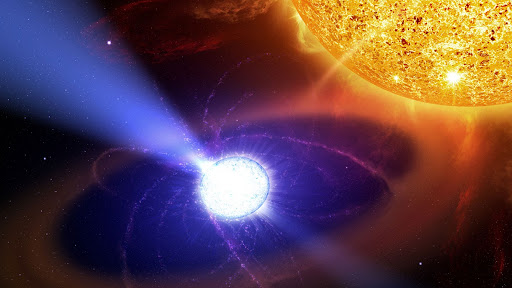Recently Discovered White Dwarf Star Fastest Ever Seen

Image Courtesy of ScienceNews.org
By Angela Hickey
2,000 lightyears away, spinning once every 25 seconds, LAMOST J0240+1952 has recently become the fastest spinning dwarf star in existence.
The fast-spinning white dwarf, located in the constellation of Aries, was discovered because of its close proximity with the red dwarf star that revolves around it.
The discovery occurred the night of August 7, when astronomer Dr. Ingrid Pelisoli and her colleagues, of the University of Warwick in Coventry, England, detected a periodic blip of light from the dim duo. The blip repeated every 24.93 seconds, revealing the white dwarf star’s record-breaking rotation period, the researchers reported on August 26, 2021.
About as small as Earth but roughly as massive as the sun, a white dwarf is extremely dense. The star’s surface gravity is so great that if you dropped a pebble from a height of a few feet, it would smash into the surface at thousands of miles per hour. The typical white dwarf normally takes hours or even whole days to spin.
For reference, the sun and moon both rotate approximately once an Earth month. LAMOST J0240+1952, on the other hand, rotates more than twice a minute. This makes it the fastest star of any kind to have ever been observed by the scientific community — not counting neutron stars, which are the collapsed cores of massive supergiant stars.
The star’s only known rival is an even faster-spinning object in orbit: the blue star HD 49798. But that rapid rotator’s nature is unclear, with some recent studies saying it is likely a neutron star, not a white dwarf.
A white dwarf star is typically what remains of another star of less than 10 solar masses when it exhausts its nuclear fuel and violently expels its outer layers into space, which is one of the stages of stellar evolution. It will pass through the vast majority of known stars, including the Sun, and, together with red dwarfs, they are the most abundant in the entire universe, the article concluded.
White dwarf stars are some of the oldest observable celestial objects in the universe, and they have been at the center of several dramatic scientific observations in recent years. Last year, for example, astronomers turned to neutron stars and white dwarf stars to help them prove Einstein’s theory of relativity via the observation of frame-dragging, the practice in which spacetime is altered by massive rotating objects.
Astronomers at the University of Warwick have also previously revealed direct observations proving that thousands of white dwarf stars in our galaxy have gradually crystallized as they cooled down over millennia and that our own sun will one day meet the same fate. This discovery means that some white dwarf stars are billions of years older than what had been previously estimated.
The oldest white dwarf of all might be roughly the same age as the universe itself, meaning that uncovering the mysteries of white dwarf stars promises to teach us a great deal about the history of the cosmos.







